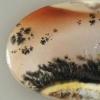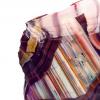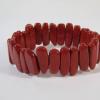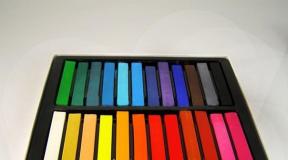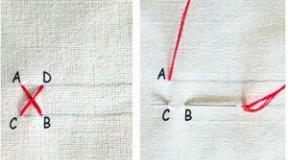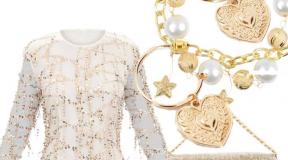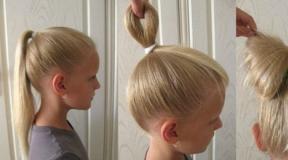The best hair dye for pregnant women: review, composition, instructions and reviews. Hair dyeing during pregnancy: all the myths, prejudices and opinions of professionals Is it possible to dye your hair during late pregnancy
Pregnant women hear from those around them that they should not dye their hair, touch their face, buy things for the baby in advance, and other advice passed down from generation to generation. Most of them are unfounded, but there are some things you really should be careful about. For example, with dyeing hair and eyebrows during pregnancy. Whether these procedures are safe for mother and child, it is better to find out before going to a beauty salon.
What is dangerous hair coloring during pregnancy
Our distant ancestors, from the point of view of superstition, considered manipulations with hair harmful. Like the fact that cutting hair, shorten the life of the baby. Then a pseudo-scientific opinion was spread that the nails and vegetation on the body, in case of damage to the structure, take vitamins for themselves to restore, and the child does not get the necessary nutrients. Scientists have long refuted these thoughts, studies have shown that all the resources of the body are directed to the development of the fetus, and parts of the mother's body receive vitamins and trace elements for their needs according to the residual principle.
Some scientists have put forward theories about the relationship of hair coloring and the development of cancer, but to this day there is no conclusive evidence.
Satisfaction with one's own appearance improves a woman's mood, and hair coloring helps to feel beautiful.The opinions of doctors regarding the possibility of dyeing hair were divided. Some believe that you should not limit yourself in the desire to be beautiful while carrying a baby or baby. Others call for pregnancy precautions.
Video: the opinion of professionals, is it possible to dye hair during pregnancy
What harm can hair and eyebrow dyeing cause to mother and child
Over the past decades, the chemical industry has come a long way, and the amount of harmful substances in paints has decreased, and some have been successfully phased out.
Some beauty salons refuse to serve pregnant clients for fear that in case of health problems in the expectant mother, they will be accused of poor quality of services.
The most dangerous ingredients in dye mixtures and their effect on the female body:
- resorcinol causes irritation of the mucous membranes of the mouth, eyes and skin, sometimes coughing. It affects the body's resistance to infectious pathogens. It provokes hormonal disorders leading to weight gain and hypothyroidism;
- ammonia is a potent toxic substance (SDYaV) that provokes attacks of vomiting and headaches. Its strong chemical odor can cause fainting. Frequent use of dyes containing ammonia makes hair dull and dry;
- paraphenylenediamine exacerbates the inflammatory processes in the body. The respiratory system is especially affected by it, but the liver and nervous system are also damaged. Thanks to the oxidation of this compound, color fastness is achieved, so up to 70% of inexpensive hair dyes contain P-phenylenediamine;
- hydrogen peroxide in high concentration can cause an allergic reaction and burn the skin. Traditionally found in lightening paints, it can affect the lungs, nervous and digestive systems;
- persulfates irritate the skin, causing damage. Frequent use of potassium, ammonium and sodium compounds contributes to the development of asthma and other lung diseases;
- lead acetate is usually found in dyes of dark shades, has a toxic effect on the human brain and nervous system;
- ethanol penetrates even through the placental barrier, harming the fetus. Causes problems with the respiratory system in women;
- formaldehyde causes defects in the development of the fetus, therefore it is included in the list of the most dangerous paint components for expectant mothers.
Contrary to popular belief, even if hazardous substances enter the mother's circulatory system, most of them do not penetrate the child protected by the placental barrier.
At what stage of pregnancy you can and cannot dye your hair
Even the most loyal gynecologists to expectant mothers do not recommend staining in the first trimester. During this period, the laying of the vital organs and functions of the unborn baby takes place, and the placenta is not fully formed. Refrain from visiting hairdressing salons or self-coloring hair and eyebrows until at least 14 weeks from conception.  Warn the master in the beauty salon about your situation, and they will pick up a hair dye with a gentle composition
Warn the master in the beauty salon about your situation, and they will pick up a hair dye with a gentle composition
If there are no contraindications, from the second trimester a woman is allowed to use paint, but not more than three times during the entire pregnancy.
Just for this period, it is desirable to select gentle hair dyes that will carefully and effectively give the hair the desired shade.
Contraindications for hair coloring for pregnant women
Before painting, weigh the pros and cons, and only then decide on a color change. It is better to postpone a visit to the hairdresser in the following cases:
- a feeling of general malaise and loss of strength, body temperature is elevated and pressure often changes upward or downward;
- the presence of open mechanical injuries of the scalp - scratches, scratching, allergic rash or inflammation of the hair follicles in the form of abscesses;
- gestational age is less than 12 weeks;
- severe toxicosis and exacerbation of the sense of smell, provoking bouts of nausea and headache;
- tendency to allergic reactions;
- ban on cosmetic procedures from the attending physician.
Tips for women who decide to color during pregnancy
For the first three months, completely refrain from staining. In addition to the formation of the systems and organs of the baby, the hormonal background of the expectant mother changes dramatically at this time. Hormones affect the development of the fetus, and chemicals can cause a disruption in the endocrine system, which is undesirable during pregnancy. In the second and third trimesters, hormones can also play a cruel joke, giving a different shade instead of the desired one. Therefore, a day before the procedure, apply a small amount of paint not only on the skin of the wrist, but also on a thin strand of hair (without touching the scalp). So they check the absence of allergies to the components of the paint and find out what color the hair will be painted.
More than once every three months, you can not paint. To avoid the need to tint the roots, choose a tone that is as close as possible to your natural hair color. Pregnancy is not the time to experiment, going from brunette to blonde and vice versa. It is best to choose strand highlighting, then you will need a small amount of paint, which means that there will be less harmful fumes. In addition, when highlighting, dyes do not come into contact with the scalp, if the technology is followed.  During pregnancy, it is better to dye your hair in a non-contact way, when the dye does not touch the scalp
During pregnancy, it is better to dye your hair in a non-contact way, when the dye does not touch the scalp
Seek help from a professional coloring master, warning the hairdresser about your situation, this will help you choose gentle dyes. The master will retreat a few centimeters from the scalp to minimize the ingress of harmful substances through the skin into the blood. Appoint a visit to the salon in the early morning so that you do not have to inhale the vapors after the procedures done by previous visitors.
If you plan to restore beauty at home, when choosing your own paint, be guided by compositions that do not contain hydrogen peroxide (peroxide), ammonia, dihydroxybenzene, aminophenol or phenylenediamine. Make sure that the room in which you will apply the paint is well ventilated and wait until it is time to wash off its remnants from the head. Strictly follow the rules specified in the instructions, and keep the dye on your hair for no longer than the recommended time. Do not forget to wear rubber gloves so that the paint does not soak into the skin and the nail plates remain natural.
I decided to clarify why you need to choose a practicing coloring specialist, and not any hairdresser. Now many courses in a short time offer to teach how to cut, dye hair and style it in hairstyles. But in such a seemingly easy task, practice is important. My classmates and I studied hairdressing for a whole academic year, half of which fell on practical classes. And then, for the first time after graduation, I felt excitement at the sight of a visitor in a chair. Many colleagues confessed the same to me. Despite the fact that the diplomas say "masters of a wide profile", each hairdresser has an occupation to which the soul lies. And if you only cut or do hairstyles for a long time, you can reach unprecedented heights in these activities and do the work with your eyes closed. And, faced with the need for staining, one has to feverishly recall the theory. It's like in everyday life, even the recipe for a familiar dish that you rarely cook, you need to refresh your memory before cooking. Otherwise, you may not get the result you expect. But if the food is easy to throw out in extreme cases, then it is difficult to recolor the hair, especially during pregnancy.
If you decide to color, in the absence of experience, in no case do not experiment on your own. In case of unwanted color, do not rush to re-dye, it is better to let your hair rest, and then use natural dyes. If the result is not at all pleasing, use wigs, but avoid those made from synthetic materials. After unsuccessful coloring, I went for six months in a natural wig. I got to the master, who, probably, for the first time in his life, took up a haircut and fooled me from behind. Looking at the result of her work, I even cried. And the yellow chicken hair color gave me acceleration in search of a false hairstyle.
The best choice for pregnant women who decide to dye will be semi-permanent organic dyes and natural dyes, such as henna or basma. It is recommended to replace traditional colors with tinted shampoos, balms or tonics.
Paints suitable for use during pregnancy
Universal recommendations about safe dyes for pregnant women cannot be obtained. It is necessary to focus on the period of bearing the child, personal preferences, the condition of the hair and the general well-being of the woman. It is advisable to seek advice from the master, because sometimes salon paints with ammonia are safer than store-bought ones without ammonia, but containing other toxic substances in even greater concentrations. For some pregnant women, it would be better to completely abandon persistent staining in favor of less harmful highlighting or coloring.
Video: doctor's opinion about staining while waiting for the baby
When choosing paint on your own in the store, carefully study the composition of the products you like. Leave paints containing P-phenylenediamine, aminophenol or dihydrobenzene on the store shelf, at least during pregnancy and breastfeeding.
Table: composition and durability of hair dyes allowed for expectant mothers
| Paint name | Characteristics of the composition | Color fastness | Consumption | Price | When to Use During Pregnancy |
| Estel Professional Deluxe Sense(Estelle Sens de Lux). | Ammonia-free paint containing avocado oil, olive extract, panthenol and keratin complex. In addition to coloring, it restores hair, saturating it with useful substances. | Retains color for up to four weeks. | From 310 rubles. | Throughout pregnancy, but best not until the second trimester. | |
| SanoTinT(Sanotint). | Vegetable paint with extracts of millet, birch, grape seeds, olive leaves. Strengthens and protects hair. Without ammonia. | Retains color for more than four weeks. | For hair of medium thickness and up to 15 cm long - 1 pack (55 g of dye. | From 1 thousand rubles. | From the second trimester. |
| Schwarzkopf Perfect Mousse(Schwarzkopf Perfect Mousse). | Ammonia-free paint-mousse, but curious users noticed a slight amount of ammonia in the composition on the packaging. However, it is negligible to do much harm. It has a pleasant fruit and berry aroma. | Keeps color vibrancy up to the 6th rinse, stays on the hair for up to 6 weeks. | One package is enough for hair up to 30 cm (with medium density). | From 285 rubles. | From the second trimester. |
| Wella Color Touch(Vella Color Touch). | Ammonia-free paint with keratin and nutrients. | Retains color for up to six weeks. | For hair of medium thickness and up to 15 cm long - 1 pack (60 g of dye). | From 390 rubles. | Only in the third trimester of pregnancy. |
| Garnier Color Shine(Garnier Color Shine). | Ammonia-free paint with argan oil and cranberry extract. Makes hair soft and shiny. | Retains color for 6-8 weeks. | For hair of medium thickness and up to 15 cm long - 1 pack (60 g of dye). | From 176 rubles. | From the second trimester. |
| Loreal Casting Creme Gloss(Loreal Casting Cream Gloss) | The paint does not contain ammonia, but it contains hydrogen peroxide, albeit a small amount. There will be no particular harm from it, except that individual intolerance in rare cases by some women. Royal jelly in the composition acts as keratin - straightens and smoothes hair. | Retains color up to 8 weeks. | For a length to the waist with an average density of hair, 2-3 packs of paint are needed. | From 324 rubles. | From the second trimester. |
Alternative to hair dye during pregnancy
For those who are still afraid to use paints while carrying a child, there is an alternative.
Natural dyes for pregnant women
They will not only help to qualitatively achieve the desired shade of hair, but also contribute to the restoration and treatment of sick and split ends.
Henna
Natural henna gives the hair a beautiful even shade. Most often it is used to obtain red hair color, the tone depends on the exposure time. Mixing in a ratio of 1 part henna: 2 parts basma gives a rich chestnut shade. Natural dyes strengthen hair, making it soft and silky. But earlier than 3 months after dyeing with chemical agents, henna cannot be used. Otherwise, the color may turn out not at all the one you expected. After a perm, it is also necessary to wait 2-3 months before using henna. To avoid a possible allergic reaction, remember to test on your wrist.
Wash your hair thoroughly and lightly dry your hair so that dirt and grease do not create a barrier to the penetration of henna into the hair structure. Be sure to clean your hair of varnish, gel or other styling products.
Pour the henna powder into a plastic container and pour a small amount of hot water, but not boiling water. Stir until the lumps are completely dissolved and add water to bring to the consistency of thick sour cream. Apply the henna mixture while still warm, do not wait for it to cool completely, otherwise the coloring properties will be lost. Start at the back of your head from roots to ends. Collect the hair with henna in the tail, wrap with a film and a towel. Leave for a while depending on the desired shade, then rinse with warm water.  Henna coloring improves the condition of the hair, but due to the hormonal background during pregnancy, the result may be unexpected.
Henna coloring improves the condition of the hair, but due to the hormonal background during pregnancy, the result may be unexpected.
More than once every two months, you should not paint with henna, especially since the color keeps well up to 10 weeks after staining. Ready-made mixtures are sold to give hair various shades - from light to dark. Before use, read the instructions.
chamomile leaves
Rinsing after washing with a weak infusion of chamomile leaves gives the hair a golden hue and natural shine.
To gently lighten the curls, take a tablespoon of dry chamomile leaves, pour 0.5 cups of boiling water and leave for 1.5–2 hours, then add henna to the hot gruel and apply to the strands.
Oak bark
Oak bark can darken hair by 1-4 shades, depending on the exposure time. The use of oak bark gives the hair volume, strength and natural shine.
Pour 4 tablespoons of crushed oak bark with a liter of boiling water, cover the container with a lid and leave to infuse for 3-4 hours. Then strain and apply to hair. Be sure to wrap the strands with cellophane for 4-5 hours, and wrap a towel over your head. The longer you hold, the darker and richer the color will be.  Infusions and decoctions of natural dyes are conveniently applied to the hair with a spray bottle.
Infusions and decoctions of natural dyes are conveniently applied to the hair with a spray bottle.
onion peel
A wonderful tool for strengthening and healing hair. Great for shading light strands.
To give the curls a light brown tint, pour 50 grams of onion peel with half a glass of hot water and boil for 20-25 minutes. Cooled to a comfortable temperature, apply the mixture to the hair, starting from the back of the head. Cover your hair with the mixture in a plastic bag and top with a towel. After 2 hours, rinse with warm water without shampoo.
Ground natural coffee
This natural coloring agent effectively allows you to get rid of the redhead and even out the color of the curls. Coloring light brown hair with ground coffee gives them a beautiful chocolate tone.
Women will appreciate the shine of their hair after dyeing it with a coffee mixture. It is easy to prepare - pour 50 grams of ground coffee with 100 milliliters of hot water and leave for 15-20 minutes. Apply to strands, warm your head with cling film and a towel. Leave for half an hour and then rinse with warm water.
Video: how to give a beautiful shade to hair with natural dyes
Please note that after chemical exposure to hair - perms or dyeing, you must wait at least 2 months before using natural dyes.
My friend, a natural blonde, gives her hair a golden hue with lemon juice. And when she wants to experiment, Alena dyes her hair with berry or vegetable juice. The color lasts until the first shampoo, but completely satisfies her passion for changes in appearance without compromising her health. Especially beautiful, in my opinion, looks like a shade obtained from dark cherries. Naturally, store-bought juice is not suitable, only freshly squeezed.
Tinted shampoos, balms and tonics
When choosing tint products, pay attention to the fact that the package says "for pregnant women." Many manufacturers have special product lines for expectant mothers. High-quality products will not harm the mother and child, buy them in trusted stores and follow the expiration date. Although shampoos and tonics are less aggressive towards hair than even ammonia-free dyes, it is still a product of the chemical industry.  Choose a tint balm, focusing not only on color and price, but also on the composition
Choose a tint balm, focusing not only on color and price, but also on the composition
Give a preliminary test for the absence of allergic reactions by applying a small amount of tonic to the skin of the wrist. Due to hormones, it may turn out to be the wrong shade or not take on the hair at all, check in advance by coloring a thin strand. Start coloring after carefully studying the instructions and do not keep the coloring balm longer than the specified time.
On the hair, the color lasts until the first shampoo, and for another week the shade is slightly noticeable. Of course, the paint is more stable than shampoos, balms and tonics, but the latter are safer for the health and well-being of pregnant women.
How dangerous is it to dye your hair during pregnancy. At what time and with what is it allowed to dye hair during pregnancy. Top 3 natural hair dyes suitable for pregnant women. Precautions and contraindications.
With the onset, a woman completely reconsiders and changes her lifestyle, now the main task of the expectant mother is to give birth to a healthy baby. All dubious procedures and products are taboo. But pregnancy is not a reason to stop caring for yourself and emphasize your beauty.
The fear of harming the baby stops many women from dyeing their hair during pregnancy, but is this procedure really that dangerous?
When deciding on any manipulation with hair, a woman needs to objectively assess her state of health and how well her pregnancy is going.
Even with perfect health, it is worth considering the following nuances:
- Until the 12th week of pregnancy, the main organs of the little man are formed. During this period, it is better to refuse even the hair itself.
- Throughout pregnancy, the hormonal background is unstable, so before dyeing your hair, you should definitely do an allergy test and preliminary (control) dyeing of one strand. Very often, the curls are stained unevenly, the paint is taken partially, which leads to an undesirable result.
- For expectant mothers, leading experts offer partial hair coloring () or.
- For the entire period of pregnancy, the staining procedure is allowed to be carried out 2-3 times no more.
Strict ban on hair coloring during pregnancy - does not exist. Doctors recommend refraining from aggressive paint and using only natural dyes in a minimal amount.
Why is it dangerous?
Many hair dyes contain harsh chemicals that can really adversely affect the health of a baby in the womb.
Chemical compounds enter the woman's blood either through the skin or through the respiratory tract and provoke certain negative reactions. The most dangerous for the health of the baby include the following:
- Resorcinol. Suppresses the immune system, provokes a strong cough and irritation of the mucous membranes of the body.
- . A powerful allergen that can lead to a chemical burn.
- Ammonia. Causes severe intoxication (nausea and severe headaches).
- Paraphenylenediamine. It provokes strong inflammatory processes in the body.
These substances pose a potential threat to the health of the child, therefore it is strongly not recommended to use paints that contain these components during the period.
How to choose hair dye?
Dye - the best solution for pregnant women. Ammonia gives a lasting coloring effect, but its vapors are very toxic. Pregnant women are advised to use softer and more gentle paints. Modern companies offer a lot of effective and relatively safe hair dyes that are suitable even for women during pregnancy.
TOP popular funds
Estel DeLuxe Sens
Compound:
- The basis is siloxanes.
- Avocado oil.
- Olive oil.
- Panthenol.
- Vitamin B5.
Palette - more than 50 natural shades, including a corrector for green, blue and yellow tones.
Peculiarities:
- Soft impact.
- Lack of smell.
- Medium durability.
- Without ammonia.
Inoa ODS2 by Loreal
Compound:
- The base is monoethanolamine.
- Blend of natural vegetable oils (olive, almond and wheat germ).
- Vitamin E.
Palette - more than 48 shades:
- Basic.
- Golden.
- Red.
- Copper.
- Ashy.
- Brown (warm and cold).
- Mother-of-pearl.
- Matte.
- Mocha.
Peculiarities:
- Without ammonia.
- Lack of smell.
- Lightening up to 3 tones.
- Delicate coloration.
- Long lasting effect (up to 6 weeks).
SanoTinT (Switzerland-Italy)
Compound:
- The basis is herbal ingredients.
- Golden millet extract.
- birch extract.
- Extraction of grape seeds.
- Olive leaf extract.
- Vitamins - and calcium pantothenate.
Palette - 42 most popular shades.
Peculiarities:
- Hypoallergenic.
- Does not contain preservatives.
- Without ammonia.
- Colors hair up to 2 tones.
- No strong odor or cosmetic fragrances.
- Mild effect on the hair.
- Along with coloring, the hair receives additional care - nutrition, hydration and strengthening.
- Persistence - short (up to 3-4 weeks).
Hair coloring algorithm during pregnancy
The procedure for dyeing hair during pregnancy is no different from classic hair dyeing.
If coloring takes place in a beauty salon, then:
- It is imperative to warn the master of his position so that he picks up paint without ammonia.
- It is advisable to carry out the procedure in the morning, in a well-ventilated area.
- Before applying paint, be sure to do an allergy test and control staining of one strand.
When dyeing hair at home, you should:
- Be sure to wear gloves.
- Provide air circulation.
- Perform the procedure in the presence of an assistant who can provide first aid in case of an unforeseen situation (dizziness, fainting, and so on).
Hair coloring process:
- In a separate container, the main dye and fixing emulsion are thoroughly mixed in the proportions indicated in the instructions.
- Using a brush, the resulting composition is evenly applied to the hair roots.
- If you need to paint over the roots, then the paint is first aged on the roots for 15 minutes, and then applied to the rest of the length and aged for another 15 minutes.
- If you want to paint the entire length at once, then starting from the roots, the paint is immediately applied to the entire length of the hair and the required amount of time is maintained from 20 to 30 minutes.
- The paint is washed off with shampoo.
- Then you can apply a moisturizer or a special fixative from the same series as the paint.
Contraindications for hair coloring during pregnancy
- Severe toxicity.
- The gestation period is up to 12 weeks.
- Exacerbation of the sense of smell, which provokes bouts of toxicosis.
- Tendency to allergic reactions.
- Mechanical damage to the scalp (scratches, abrasions, pustules, rashes, open wounds).
- General malaise and feeling unwell, loss of strength, pressure surges, fever, fever.
- The doctor's ban on the procedure for dyeing hair for medical reasons.
A woman who is used to constantly taking care of her appearance, emphasizing her beauty and individuality with the help of hairstyles and makeup, should not give up this during
Can you dye your hair while pregnant? Some argue that an interesting position should not become an obstacle to proper self-care. Others oppose this procedure.
To paint or not to paint - what do doctors say?
To answer this question, we decided to turn to experienced professionals. The opinion of the doctors turned out to be unequivocal - it is extremely undesirable to dye your hair during an "interesting situation". Here are some important reasons why.
Reason #1. The chemical composition of paints
The composition of modern paints includes a lot of very harmful chemical components:
- Resorcinol - provokes a cough, causes redness of the skin and mucous membranes, reduces immunity;
- Peroxide - can cause burns or severe allergies;
- Ammonia - increases nausea, leads to severe migraines;
- Paraphenylenediamine - is a common cause of inflammation;
- Sodium lauryl sulfate - present in mousse paints, as well as most other cosmetics, is one of the most dangerous carcinogens, accumulates in the blood and affects all vital organs;
- Perfumes or fragrance - toxic substances that are hazardous to health;
- P-phenylenediamine - is part of dark tones, causes allergies, headaches, nausea and flushing of the skin;
- Formaldehyde donors - provoke asthma and allergies;
- Parabens (E216) - cause breast cancer, can accumulate not only in the body, but also in breast milk.
On a note! Some experts argue that the small dose of chemical components that enters the blood during the staining process is not able to affect the development of the fetus. In addition, the child himself is surrounded by a dense placenta, which protects him from negative influences. So it's up to you to decide.
Reason #2. Hormonal disbalance
There is one more point - also no less important. The fact is that with the onset of pregnancy, there are sharp jumps in hormonal levels that can affect the result of the procedure. In this case, even your favorite paint can lead to the development of an allergic reaction or give a different shade to which you are used to.
Reason #3. Hair condition
The expectant mother is experiencing an acute shortage of calcium and vitamins, as a result of which her hair becomes thin and weak. Additional exposure to permanent dyes will only worsen their condition.
Reason #4. Heightened sense of smell
The main distinguishing feature of a pregnant woman is not even a huge belly, but an overly sharp scent. During an interesting situation, accompanied by bouts of toxicosis, almost any smell can irritate her. What can we say about the paint with its sharp aroma ?!
Reason #5. And the last important factor - working for two, the body of the expectant mother is experiencing increased stress, against which the woman becomes weaker and more sensitive. Just for this reason, hair coloring can harm her health.

When should pregnant women not dye their hair?
Throughout all 9 months, there are two "dangerous" periods during which a staining session cannot be performed:
- The first 16 weeks - it is in the early stages that all vital systems are formed, so any negative intervention can lead to the development of severe pathologies (absence, deformation or insufficient development of certain organs);
- The last 2-3 weeks - at this time, preeclampsia or late toxicosis is very often observed. Both conditions are extremely dangerous for both the baby and the pregnant woman herself.
It should also be noted that both in the first and in the last trimester, the likelihood of miscarriage increases significantly, so it would be better to postpone any hairdressing manipulations. But in the second trimester, the fetus is reliably protected, so you have the opportunity to think about yourself.
Important! But even at this time, you need to dye your hair with extreme caution. At the slightest malaise or severe toxicosis, dyeing the hair should be immediately abandoned. Remember, the deterioration of your health will instantly affect the condition of the fetus. Other contraindications for staining can also include a difficult pregnancy and a tendency to allergies.

What is the best way to dye your hair?
There are a number of safe dyes that expectant mothers can color strands with. These include:
- Soft paints do not contain harmful substances, therefore they do not pose a health hazard. However, it should be noted that some unscrupulous manufacturers replace ammonia and peroxide with no less aggressive components. It is for this reason that it is better to entrust the choice of a dye without ammonia to an experienced cosmetologist who is well versed in the composition of hair cosmetics. The most popular sparing paints include Wella Color Touch, Schwarzkopf Perfect Mousse, Igora, Loreal Casting Crème Gloss, Chi, Essential Color from Schwarzkopf, Garnier Color Shine and Matrix;
- Toning products (balms, sprays, shampoos, etc.) - do not have an unpleasant odor, do not contain hazardous ingredients, envelop the strands without disturbing the structure. Having decided to dye your hair with a tonic, you will not only reduce the risk of a negative impact on the baby to a minimum, but also improve the condition of your hair;
- Natural dyes. Dyeing your hair with natural dye can be called the safest solution. Feel free to use henna, onion peel, basma, chamomile, coffee, honey, cocoa and other improvised means - they are not only absolutely safe, but also very useful. After using these products, your hair will become strong, shiny and silky.
Important! Before using both ammonia and ammonia-free paint, be sure to conduct a preliminary allergy test. To do this, lubricate the inner bend of the elbow with a small amount of the composition and wait 10 minutes. If redness, rashes and other unpleasant phenomena do not occur on the treated area, feel free to proceed to applying the product to the head.

How to get a stylish tone with natural remedies?
Having decided to tint your hair with natural dyes, use a selection of the most popular and effective recipes.
mahogany color
The shade of mahogany will make your look bright, and facial features - more expressive.
- Mix 1 packet of henna with 4 tbsp. l. cocoa.
- Wrap your head in a cap.
- Wait 40 minutes.
- Wash off with running water.

black tint
You can get both bronze and black hair color. The main thing is to change the proportions!
- Mix henna and basma, taken in equal amounts.
- Pour the mixture with a small dose of hot water - its consistency should resemble gruel.
- Apply the composition to clean hair.
- Keep at least an hour.
- Wash off with running water.

golden shade
The golden tone suits both blondes and fair-haired.
- Pour 200 ml of water 2 tbsp. l. onion peel.
- Boil for 20 minutes.
- Cool, filter and apply to strands.
- Hold for half an hour.
- Wash off with running water.

Reddish-brown tone
This color is suitable for those who have gray hair - with its help, you can not only skillfully hide the first signs of age, but also give light brown strands a mischievous red undertone.
- Connect 2 tbsp. l. brewed coffee with 1 sachet of henna.
- Pour the mixture with a small amount of hot water - its consistency should resemble gruel.
- Apply the composition to clean hair.
- Hold 30 minutes.
- Wash off with water without shampoo.

wheat shade
To give your hair a beautiful wheaten tone, you need no more than an hour and very little money.
- Pour 200 ml of boiled water 3 tbsp. l. pharmaceutical chamomile.
- Insist 20 minutes.
- Filter through a sieve.
- Soak your hair liberally in chamomile tea.
- Wrap yourself in a cap.
- Wait 30 minutes.
- Wash off with running water.

Dark chestnut shade
Both brown-haired women and brunettes are ideally suited for a dark chestnut tone. Dyeing strands with this tool is not a bit harmful, and the result is 100%!
- Brew strong tea - drop 3 tbsp into one glass of water. l.
- Let the mixture brew and strain through a sieve.
- Soak your hair and wrap it in a cap.
- Wait 40 minutes and rinse with running water.
Advice! Exactly the same effect can be obtained from linden, cinnamon and green walnut peel.

Reddish golden tone
Another option for natural blondes and fair-haired ladies.
- Pour 200 ml of hot chamomile infusion into 1 sachet of henna.
- Let the product stand for approximately 15 minutes.
- Strain through a sieve.
- Soak your hair.
- Wash off after half an hour.

bronze shade
To give your hair a bright bronze tint, use henna and basma:
- Combine 1 part of basma with 2 parts of henna.
- Pour the mixture with a small amount of hot water - its consistency should resemble gruel.
- Apply the composition to clean hair.
- Wait 30 minutes (the longer, the brighter the color).
- Wash off with running water.

Important! When using natural dyes, pregnant women should remember a few important points:
- They have a cumulative effect, so to get the perfect result, the procedure should be done about once every 2 weeks;
- The composition must be applied to the entire length of the hair. You can do this with a brush or a kitchen sponge;
- Hair that has recently been permed should in no case be dyed with basma or henna - at least a month should pass between these sessions. This prohibition also applies to recent staining with permanent paints;
- Henna can be very drying, so don't forget to regularly care for your hair with fluids, masks, rinses, balms, and other products.
Is it possible for expectant mothers to radically change color?
Pregnant women are categorically contraindicated in a sharp change in image. This is due to the fact that staining in contrasting colors can only be done with the help of a clarifier and resistant paint, the use of which is fraught with unpleasant complications. If you paint the strands with a more gentle product, the tone will wash off very quickly and ruin your whole look. It is for these reasons that expectant mothers are advised to stick to the usual color palette.
Tips and tricks on how to color your hair during pregnancy:
If you are determined to wear makeup during pregnancy, take note of these helpful tips:
- Give preference to those shades that resemble your own hair color. So you will be less worried about growing roots and save yourself from frequent color corrections;
- Repeat the procedure no more than 1 time per trimester;
- When dyeing your hair in the salon, be sure to notify the master of your position (unless, of course, it is already noticeable). This will allow the hairdresser to pick up gentle preparations and carry out a change in tone with little or no harm;
- In order not to inhale the chemical fumes left over from previous paintings, schedule a session in the morning;
- Carry out the procedure outdoors or in a room that is well ventilated. This rule applies to both early and later dates;
- To avoid mistakes, apply the composition on one thin strand, wait the right time and evaluate the result;

- Do not keep the dye longer than the period indicated in the instructions (the only exception is some natural remedies);
- Rinse off the paint well so that the water is clear;
- Replace full staining with other gentle techniques. So you can stay well-groomed and beautiful not only in the first or second, but even in the third trimester.
Important! Frequent dyeing, especially for short periods, can cause brittleness and hair loss.
As you can see, you can dye strands during pregnancy only at a certain time. And in order to completely eliminate all the risks associated with this event, consult both a cosmetologist and a gynecologist observing you.
During pregnancy, a woman has many prohibitions and fears. Some of them are justified, others are irrational. Many women are sure, for example, that it is impossible to dye their hair during pregnancy. But is it really so? And who decided that coloring during pregnancy is harmful? When it comes to such an important detail as beauty, clarity is needed. We checked the study, interviewed experts and found out what the most popular "pregnant" fears about hair coloring are based on.
creative director of the Proscenium stylist school; Roman Vergovsky
Below we have collected the most common statements regarding hair coloring during pregnancy. Most of them are passed from mouth to mouth without being questioned. As a result, many future mothers deny themselves the pleasure of looking beautiful for the whole 9 months. And after childbirth, another round of superstitions begins. But more about that another time. And now - about what most pregnant women are sure of:
“The smell of ammonia leaves no doubt about the exceptional harm of this substance, so it’s better to be patient and not dye your hair during pregnancy.”
Ammonia does affect the olfactory organs and can irritate the mucous membranes of the eyes and respiratory tract, but you can’t do without it. To fill the hair with pigment, you need to deliver it to the core, and this is what ammonia does. It opens the scales of the surface layer of the hair (cuticle), and lets the pigment in. But this is not a reason to refuse staining.
In fact: Ammonia is a natural chemical compound of nitrogen and hydrogen, related to the human body. It is found in the blood and urine, is present in medicines, for example, in ammonia-anise drops, which are approved for use even by pregnant women.
Like any substance, ammonia can be both a medicine and a poison, it's all about the quantity. When staining, you can check with the master what percentage of it is contained in the dye, on average, the figure is from 1.4 to 2.5%. The smaller it is, the softer the impact.
It's important to know: In resistant paints sold in mass markets, the percentage of ammonia is always as high as possible - the calculation is for a consumer who does not know the intricacies of staining. The paint should cover the gray hair in any case, hence the guaranteed penetration to the entire depth of the hair and the durability of the dye. As a rule, here, too, the percentage of ammonia is in the zone of acceptable values. However, it is important to consider that the dark shades of little-known manufacturers may contain salts of heavy metals, their accumulation in the body is much more dangerous.
“It’s better not to risk it and choose an ammonia-free dye, at least it is 100% harmless.”
But this, alas, has not been proven. Now many manufacturers produce "ammonia-free" paint. But what replaced the "harmful" ammonia? Indeed, without it, the pigment, as we already know, cannot penetrate into the depths of the hair.
Monoethanolamine is a colorless liquid that has the property of ammonia to open the hair cuticle. Due to the absence of smell, this substance often causes unconditional confidence.
In fact: Monoethanolamine is a synthetic substance, and its safety has not yet been proven and is rather a marketing move by the manufacturer.
“The paint penetrates into the blood, and even if the harm is invisible now, in the future it will come back to haunt the baby’s allergies and other problems more than once.”
Scientific experiments on the effects of dyes on the health of pregnant women and babies, for obvious reasons, have never been carried out. But scientists are monitoring, and for many years direct evidence of harm has not been found. Which is not surprising, because when the paint comes into contact with the scalp, the percentage of absorption of substances into the blood is too small.
In fact: Even if a small part of the harmful substances reaches the fetus's habitat, it will not get inside, because the baby is surrounded by the placenta, which filters everything that comes close to the fetus and does not let uninvited guests through the so-called "placental barrier".
“Pregnancy is the time to remember henna and basma.”
Not at all necessary. If the natural shades of henna and basma are already familiar and suitable, you can continue to have fun. But if the gray hair is not painted over evenly, it is better to paint the roots with a resistant paint (it is she who copes with the gray hair), and keep the color natural along the length.
All women during pregnancy, as in everyday life, want to be beautiful. Not the last role in the field of female beauty is played by hair color. After all, beautiful curls are the calling card of every woman.
There are a lot of myths and horror stories about dyeing curls while waiting for a child, so very often, even women who are far from all sorts of superstitions doubt whether it is possible to dye their hair during pregnancy? And if it is still possible, then how to color the strands while waiting for the child, so as not to harm yourself, or the baby in the womb? Let's figure it out.
In contact with
A bit of history
The strict ban on hair coloring has its roots in deep antiquity when human strands were assigned a special magical role.
Important! At that time, women were strictly forbidden to cut curls, and men - beards.
 People then firmly believed that hair was endowed with special power, and cutting them is like depriving yourself of strength and energy.
People then firmly believed that hair was endowed with special power, and cutting them is like depriving yourself of strength and energy.
And although painting, as such, did not exist at all at that time, any manipulations with the hair were forbidden.
It was these traditions that provoked many myths about the prohibition of painting and even cutting curls.
A huge role in this matter is given to means for painting. And if it's about synthetic paint, which contains ammonia in its composition, then the answer to the question of whether it is possible for pregnant women to dye their hair with paint is unequivocal: it is impossible.
Damage to permanent paint
Is it safe to dye your hair during pregnancy? Coloring with permanent paint can have an extremely negative impact on the health of not only the expectant mother, but also the child. After applying funds the following consequences are possible:
- Seizures, soreness in the head area can provoke ammonia in the composition of the coloring agent.
- Skin allergies and even chemical burns can trigger peroxide.
- A substance called resorcinol, which is found in permanent paints, can irritate mucous membranes. Such an aggressive chemical element can provoke a decrease the body's defenses, which is extremely undesirable for a future mother, whose immunity is already reduced due to the natural restructuring of the body.
- Inflammatory processes in the body can cause paraphenylenediamine, which is also present in coloring agents.
Of course, it is impossible to say for sure that the use of ammonia paint will definitely harm the unborn child. Such a statement would be fundamentally wrong also in view of the fact that such research has not been done. And no one specifically painted pregnant women to find out how dyeing would affect the fetus. In addition, the placenta is a true protector of the fetus, which, like a high-quality filter, passes nutrients to the baby and does not allow harmful chemical compounds.
H can you dye your hair
 If the future mother is haunted by an irresistible desire to dye the strands, then it is better to use ammonia-free paint.
If the future mother is haunted by an irresistible desire to dye the strands, then it is better to use ammonia-free paint.
It is a safe dye for pregnant women. Natural dyes of organic origin in such products do not have an aggressive effect on the human body.
Of course, organic dyes are not as resistant as conventional synthetic ammonia dyes, but they are much safer.
Tinted shampoos are also less safe than synthetic paints. Such products also cannot be called completely safe, but the chemical components in their composition are much less aggressive than the substances in paints.
The safest hair dye for pregnant women is natural henna or basma. Henna during the period of expectation of the child has absolutely no undesirable effects either for the mother or for the child. Moreover, henna during pregnancy will strengthen the curls, get rid of dandruff, give the hair shine and silkiness, and even enhance their growth.
Hair coloring during pregnancy can appear in the most unpredictable color, which can be radically different from the desired shade. It's all about hormonal changes in the body. Also during the period, a woman is more prone to manifestations of allergic reactions, and any coloring agent can provoke an allergy.
When can you dye your hair?
 At what stage of pregnancy can you dye your hair? This is an equally important issue. Hair color change in early pregnancy absolutely not recommended.
At what stage of pregnancy can you dye your hair? This is an equally important issue. Hair color change in early pregnancy absolutely not recommended.
The first 12 weeks after conception is the most important stage of pregnancy. It is in the early stages that the fetus is formed and all the internal organs of the unborn child are laid.
During this period, even the slightest impact on the fetus of chemicals can have an extremely negative impact on the condition of the unborn baby.
Even safe hair dye for pregnant women is not recommended for use in the early stages of expectation of a child.
It is best to use ammonia-free paint already during pregnancy, if the need arises. Better yet, use henna during pregnancy to be sure that the dye will not harm the baby in the womb.
When painting, you must adhere to the following recommendations:
- Do not use any coloring agents. Synthetic paint during this period can harm the crumbs. Henna will not have a negative effect on the fetus, but due to changes in the hormonal background in the female body, the color can turn out to be unpredictable.
- In the second and third trimesters of an interesting situation, if there is a need to use coloring agents, you should try to use them as little as possible. The color should be chosen as close as possible to natural, so as not to complex about regrown tips.
- Before dyeing your hair, be sure to check for a possible allergic reaction: apply a small amount of dye to the skin on the wrists from the inside. If after a few minutes redness does not appear on the skin, and if you do not feel itching and discomfort in this place, then the product will not cause allergies. It is also necessary to first color a small strand to make sure that the color will turn out the way you need it.
- During pregnancy, use exclusively sparing ammonia-free paints, tint shampoos, or henna.
- If before pregnancy you never dyed curls, then with the onset of an interesting situation, also don't experiment. Better do it after childbirth.
- If you decide to change your hair color in a beauty salon, you should definitely inform the master about your interesting situation.
Attention! While waiting for a child, never keep the paint on your hair for more than the period recommended in the instructions.
Useful video: is it possible to dye hair during pregnancy
Conclusion
Why you can not dye your hair during pregnancy, we found out. But if, nevertheless, there is an urgent need for painting curls, choose a gentle remedy and use the above tips and recommendations. After all, the health of the unborn child is the highest value, and taking care of it is the sacred duty of every future mother. Study at the link.
In contact with



